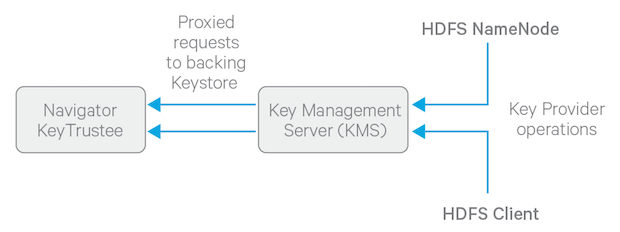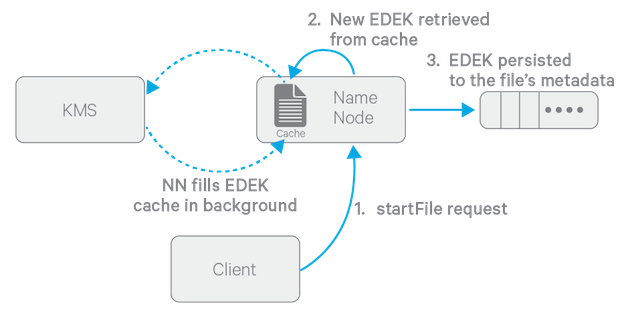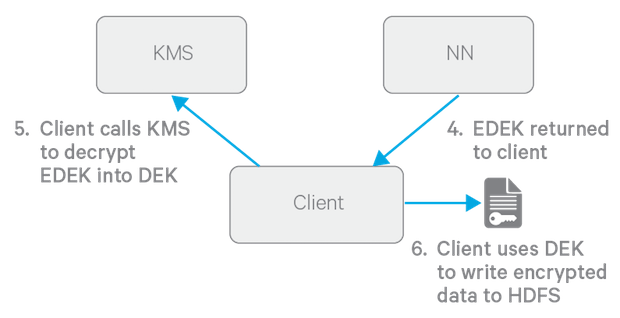HDFS Transparent Encryption
Data encryption is mandatory for many government, financial, and regulatory entities, worldwide, to meet privacy and other security requirements. For example, the card payment industry has adopted the Payment Card Industry Data Security Standard (PCI DSS) for information security. Other examples include requirements imposed by United States government's Federal Information Security Management Act (FISMA) and Health Insurance Portability and Accountability Act (HIPAA). Encrypting data stored in HDFS can help your organization comply with such regulations.
Introduced in CDH 5.3, transparent encryption for HDFS (see "New in CDH 5.3: Transparent Encryption in HDFS") implements transparent, end-to-end encryption of data read from and written to HDFS blocks across your cluster. Transparent means that end-users are unaware of the encryption/decryption processes, and end-to-end means that data is encrypted at-rest and in-transit.
- Only HDFS clients can encrypt or decrypt data.
- Key management is external to HDFS. HDFS cannot access unencrypted data or encryption keys. Administration of HDFS and administration of keys are separate duties encompassed by distinct user roles (HDFS administrator, Key Administrator), thus ensuring that no single user has unrestricted access to both data and keys.
- The operating system and HDFS interact using encrypted HDFS data only, mitigating threats at the OS- and file-system-level.
- HDFS uses the Advanced Encryption Standard-Counter mode (AES-CTR) encryption algorithm. AES-CTR supports a 128-bit encryption key (default), or can support a 256-bit encryption key when Java Cryptography Extension (JCE) unlimited strength JCE is installed.
- HDFS encryption has been designed to take advantage of the AES-NI instruction set, a hardware-based encryption acceleration technique, so your cluster performance should not adversely affected by configuring encryption. (The AES-NI instruction set can be an order of magnitude faster than software implementations of AES.) However, you may need to update cryptography libraries on your HDFS and MapReduce client hosts to use the acceleration mechanism. See "Optimizing Performance for HDFS Transparent Encryption" for details.
Keystores and the Hadoop Key Management Server
Integrating HDFS with an external, enterprise-level keystore is the first step to deploying transparent encryption. This is because separation of duties between a key administrator and an HDFS administrator is a very important aspect of this feature. However, most keystores are not designed for the encrypt/decrypt request rates seen by Hadoop workloads. This led to the development of a new service, called the Hadoop Key Management Server (KMS), which serves as a proxy between HDFS clients and the backing keystore. Both the keystore and Hadoop KMS must use Hadoop’s KeyProvider API to interact with each other and with HDFS clients.
While HDFS encryption can be used with a local Java KeyStore for key management, Cloudera does not recommend this for production environments where a more robust and secure key management solution should be used. Cloudera offers the following two options for enterprise-grade key management:
- Cloudera Navigator Key Trustee Server is a key store for managing encryption keys. To integrate with the Navigator Key Trustee Server, Cloudera provides a custom KMS service, Key Trustee KMS.
- Hardware security modules (HSM) are third-party appliances that provide the highest level of security for keys.
The diagram below illustrates how HDFS clients and the NameNode interact with an enterprise keystore through the Hadoop Key Management Server. The keystore can be either the Cloudera Navigator Key Trustee Server or a support HSM.

To get started with deploying the KMS and a keystore, see Enabling HDFS Encryption Using
the Wizard
.
For information on configuring and securing the KMS, see Configuring the Key Management
Server (KMS)
and Securing the Key Management Server (KMS)
This section describes the various KMS solutions available, and identifies criteria often used for selecting each.
Key Trustee KMS with Key Trustee Server
- Enterprise-grade key management is required
- Encryption zone key protection by an HSM is not required
Key Trustee KMS with Key Trustee Server and Key HSM
- Enterprise-grade key management is required
- Encryption zone key protection by an HSM (as root of trust) is required
- Performance for encryption zone key operations is critical
Encryption Zones and Keys
HDFS transparent encryption introduces the concept of an encryption zone (EZ),
which is a directory in HDFS whose contents will be automatically encrypted on write and
decrypted on read. Encryption zones always start off as empty directories, and tools such as
distcp with the -skipcrccheck -update flags can be used
to add data to a zone. (These flags are required because encryption zones are being used.)
Every file and subdirectory copied to an encryption zone will be encrypted.
Each encryption zone is associated with a key (EZ Key) specified by the key administrator when the zone is created. EZ keys are stored on a backing keystore external to HDFS. Each file within an encryption zone has its own encryption key, called the Data Encryption Key (DEK). These DEKs are encrypted with their respective encryption zone's EZ key, to form an Encrypted Data Encryption Key (EDEK).
The following diagram illustrates how encryption zone keys (EZ keys), data encryption keys (DEKs), and encrypted data encryption keys (EDEKs) are used to encrypt and decrypt files.

EDEKs are stored persistently on the NameNode as part of each file's metadata, using HDFS extended attributes (implemented as of Cloudera CDH 5.2). EDEKs can be
safely stored and handled by the NameNode because the hdfs user does not
have access to the EDEK's encryption keys (EZ keys). Even if HDFS is compromised (for
example, by gaining unauthorized access to a superuser account), a malicious user only gains
access to the encrypted text and EDEKs. EZ keys are controlled by a separate set of
permissions on the KMS and the keystore.
An EZ key can have multiple key versions, where each key version has its own distinct key material (that is, the portion of the key used during encryption and decryption). Key rotation is achieved by bumping up the version for an EZ key. Per-file key rotation is then achieved by re-encrypting the file's DEK with the new version of the EZ key to create new EDEKs. HDFS clients can identify an encryption key either by its key name, which returns the latest version of the key, or by a specific key version.
For more information on creating and managing encryption zones, see Managing Encryption
Keys and Zones
.
Accessing Files Within an Encryption Zone
To encrypt a new file, the HDFS client requests a new EDEK from the NameNode. The NameNode then asks the KMS to decrypt it with the encryption zone's EZ key. This decryption results in a DEK, which is used to encrypt the file.


The diagram above depicts the process of writing a new encrypted file. Note that the EDEK cache on the NameNode is populated in the background. Since it is the responsibility of KMS to create EDEKs, using a cache avoids having to call the KMS for each create request. The client can request new EDEKs directly from the NameNode.
To decrypt a file, the HDFS client provides the NameNode with the file's EDEK and the version number of the EZ key that was used to generate the EDEK. The NameNode requests the KMS to decrypt the file’s EDEK with the encryption zone's EZ key, which involves checking that the requesting client has permission to access that particular version of the EZ key. Assuming decryption of the EDEK is successful, the client then uses this DEK to decrypt the file.
Encryption and decryption of EDEKs takes place entirely on the KMS. More importantly, the client requesting creation or decryption of an EDEK never handles the EZ key. Only the KMS can use EZ keys to create and decrypt EDEKs as requested. It is important to note that the KMS does not store any keys, other than temporarily in its cache. It is up to the enterprise keystore to be the authoritative storage for keys, and to ensure that keys are never lost, as a lost key is equivalent to introducing a security hole. For production use, Cloudera recommends you deploy two or more redundant enterprise key stores.

